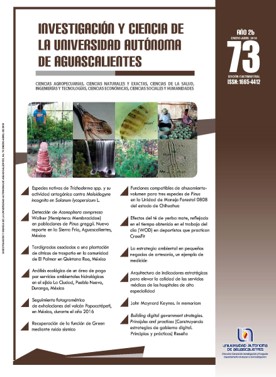Efectos del té de yerba mate, reflejado en el tiempo obtenido en el trabajo del día (WOD) en deportistas que practican CrossFit
DOI:
https://doi.org/10.33064/iycuaa201873208Palabras clave:
té de yerba mate, rendimiento, CrossFit, ergogénico, suplemento, resistenciaResumen
Actualmente el consumo de suplementos para mejorar el rendimiento ha aumentado sin considerar las consecuencias que ocasionan si no se toman apropiadamente. La yerba mate ha sido considerada una candidata contra enfermedades como la obesidad por sus múltiples efectos como: disminución en la diferenciación de adipocitos y triglicéridos, incremento de la tasa metabólica, función antioxidante y antiinflamatoria. Los beneficios en el deporte no han sido esclarecidos, por lo cual se consideró el estudio de los efectos del té de yerba mate en el rendimiento de deportistas que practican CrossFit habitualmente (n= 30). Treinta minutos antes de la prueba consumieron 300 ml de té de yerba mate, el rendimiento fue evaluado en términos de tiempo total de ejecución de rutina. Se observó un efecto positivo en el tiempo de rutina cuando el té de yerba mate fue ingerido (4:46 minutos vs. 4:12 minutos) p= 0.001.
Descargas
Citas
Alfredo Cabañes, J. J., & Salinero, J. C. (2013). La ingestión de una bebida energética con cafeína mejora la fuerza-resistencia y el rendimiento en escalada deportiva. Archivos de Medicina del Deporte, 30(4), 215-220.
Alkhatib, A. (2014). Yerba Maté (Illex Paraguariensis) ingestion augments fat oxidation and energy expenditure during exercise at various submaximal intensities. Nutrition & Metabolism, 11, 42.
Bastos, D. H. M., De Oliveira, D. M., Matsumoto, R. L. T., Carvalho, P. O., & Ribeiro, M. L. (2007). Yerba maté: Pharmacological properties, research and biotechnology. Medicinal and Aromatic Plant Science and Biotechnology, 1(1), 37-46.
Burke, L., & Deakin, V. (2006). Clinical Sports Nutrition (3rd. ed., pp. 485-580). Sydney-NY: McGraw-Hill.
Crossfitbath. (2017). Blog: WOD19-01-2018 [Fotografía]. Recuperado de http://crossfitbath.com/wod-19-1-18/#iLightbox[gallery10604]/0
Del Coso, J., Muñoz, G., & Muñoz-Guerra, J. (2011). Prevalence of caffeine use in elite athletes following its removal from the World Anti-Doping Agency list of banned substances. Applied Physiology Nutrition,and Metabolism, 36(4), 555-561.
Filip, R., López, P., Giberti, G., Coussio, J., & Ferraro, G. (2001). Phenolic compounds in seven South American Ilex species. Fitoterapia, 72(7), 774-778.
Gambero, A., & Ribeiro, M. L. (2015). The positive effects of yerba maté (Ilex paraguariensis) in obesity. Nutrients, 7(2), 730-750.
Gómez-Juaristi, M., Martínez-López, S., Sarria, B., Bravo, L., & Mateos, R. (2017). Absorption and metabolism of yerba mate phenolic compounds in humans. Food Chemistry, 240, 1028-1038. doi: 10.1016/j.foodchem.2017.08.003
González-Gallego, J., Garrido Pastor, J., Mataix Verdú, J., & Villegas García, J. (1988). Nutrición y ayudas ergogénicas en el deporte. Arch. Medicina del Deporte.
Heck, C. I., & De Mejia, E. G. (2007). Yerba Mate Tea (Ilex paraguariensis):
A comprehensive review on chemistry, health implications, and technological considerations. Journal of Food Science, 72(9), R138-R151.
Kang, Y. R., Lee, H. Y., Kim, J. H., Moon, D. I., Seo, M. Y., Park, S. H.,…Oh, H. G. (2012). Anti-obesity and anti-diabetic effects of Yerba Mate (Ilex paraguariensis) in C57BL/6J mice fed a highfat diet. Laboratory Animal Research, 28(1), 23-29.
Ledon, J. A., & Tosti, A. (2017). CrossFit-associated allergic contact dermatitis. Dermatitis, 28(6), 368. doi: 10.1097/DER.0000000000000321
Maiocchi, M. G., Del Vitto, L. A., Petenatti, M. E., Marchevsky, E. J., Avanza, M. V., Pellerano, R. G., & Petenatti, E. M. (2016). Composición multielemental y valor nutricional de “dumosa” (Ilex dumosa), “yerba mate” (I. paraguariensis) y su mezcla comercial en diferentes formas de uso. FCA UNCUYO, 48(1), 145-159.
Martinet, A., Hostettmann, K., & Schutz, Y. (1999). Thermogenic effects of commercially available plant preparations aimed at treating human obesity. Phytomedicine, 6(4), 231-238.
Myung-Sook , C., Hyo Jin , P., Sang Ryong , K., Do Yeon , K., & Un Ju , J. (2017). Long-term dietary supplementation with yerba mate ameliorates obesity and metabolic disorders in mice by regulating energy expenditure and lipid metabolism. Journal of Medicinal Food, 20(12), 1168-1175.
Poston, W. S., Haddock, C. K., Heinrich, K. M., Jahnke, S. A., Jitnarin, N., & Batchelor, D. B. (2016). Is high-intensity functional training (HIFT)/crossfit safe for military fitness training? Mil Med, 181(7), 627-637.
Sánchez Oliver, A. J., Miranda León, M. T., & Guerra Hernández, E. (septiembre de 2008). Estudio estadístico del consumo de suplementos nutricionales y dietéticos en gimnasios. ALAN Archivos Latinoamericanos de Nutrición, 58(3), 221-227.
Santesteban Moriones, V., & Ibáñez Santos, J. (2017). Ayudas ergogénicas
en el deporte. Nutrición Hospitalaria, 34(1), 204-215.
Schubert, M. M., Astorino, T. A., & Leal Azevedo, J. (2013). The effects of caffeinaited “energy shots” on time trial performance. Nutrients, 5(6), 2062-2075.
Smith, M. M., Sommer, A. J., Starkoff, B. E., & Devor, S. T. (2015). Crossfit-based high-intensity power training improves maximal aerobic fitness and body composition. Journal of Strength and Conditioning Research, 29(10): e1. doi: 10.1519/JSC.0b013e318289e59f
Woolsey, C., Waigandt, A., & Beck, N. C. (2010). Athletes and energy drinks: Reported risk-taking and consequences from the combined use of alcohol and energy drinks. Journal of Applied Sport Psychology, 22(1), 65-71.
Descargas
Publicado
Cómo citar
Licencia
Las obras publicadas en versión electrónica de la revista están bajo la licencia Creative Commons Atribución-NoComercial-CompartirIgual 4.0 Internacional (CC BY-NC-SA 4.0)









